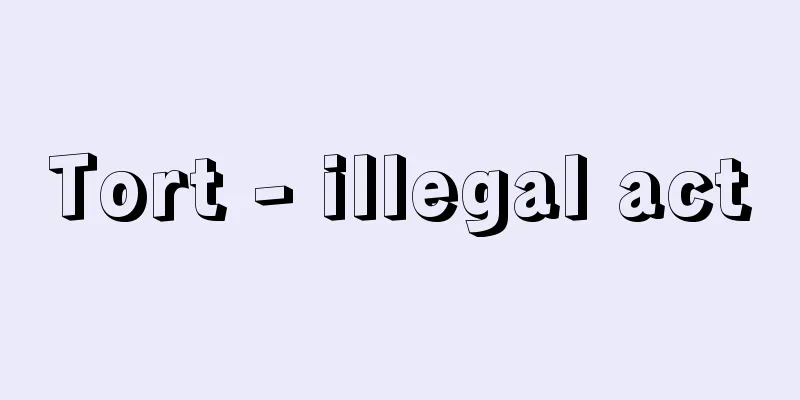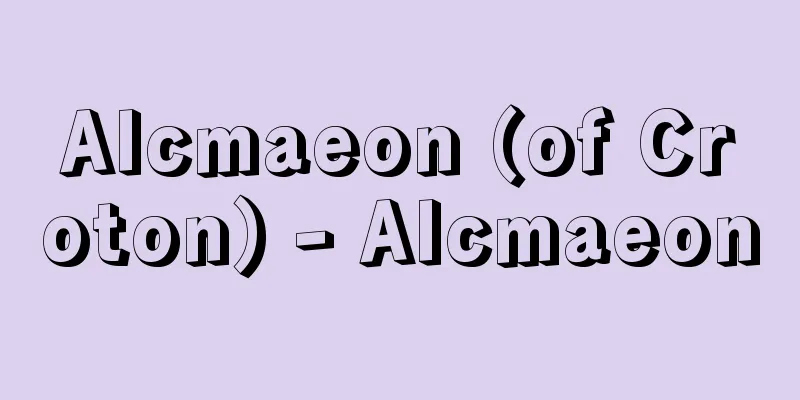Tort - illegal act

|
When a certain act results in liability to compensate another person for damages, this refers to that act or the system that gives rise to such compensation. It is another important cause of the occurrence of credit and debt, along with contracts. [Takahisa Awaji] Requirements for establishmentTorts can be broadly divided into those that require intent or negligence, but are intended to be generally applied without limiting the form of the act (Civil Code Article 709), and those that limit the form of the act but relax the negligence requirement (Civil Code Articles 714 to 719). The former are called general torts, and the latter are called special torts. (1) The general requirements for a tort are that damage has occurred, that there is a causal relationship between the tortious act and the damage, that the tortfeasor has intent or negligence, that the victim's rights have been violated (or that the tortfeasor act is illegal), and that the tortfeasor is responsible for his or her actions. Of these, the factors that are most often problematic in case law and academic theory are causation, intent or negligence, and infringement of rights (or illegality). A particular problem with causation is how to ease the difficulty of proving it, and in pollution/drug damage cases and medical malpractice cases, which have become more frequent since the 1970s, the burden of proof borne by plaintiffs has been eased in a variety of ways depending on the case, such as theories of probability (degree of possibility), tentative presumptions, statistical proof, and epidemiological proof. In a 1975 ruling, the Supreme Court held that, generally speaking, proving causation is proving a high degree of probability that the relationship in which a specific fact caused a specific result can be accepted by comprehensively examining all evidence in light of empirical rules, and that this judgment should be one in which one can be convinced of its veracity to a degree that leaves no room for doubt. In the case of intent and negligence, "intent" is the act of knowing that a certain result will occur, and "negligence" is the careless failure to know that a certain result will occur. In recent years, however, the definition of negligence has been generally understood as a violation of the obligation to perform or not perform a certain act. In case law, "negligence" has been recognized when a result was foreseeable, but the result was not avoided due to a violation of the duty of care. Foreseeability is premised on a duty of foresight, such as a duty of research, in the case of dangerous acts (for example, corporate activities that cause pollution). "Rights violation" was once understood in the narrow sense of a violation of a specific right, but has since come to be understood to mean "illegality" in a broader sense (illegality theory). Under this illegality theory, the presence or absence of illegality is determined based on the correlation between the nature of the tortious act and the type of interest violated and the seriousness of the violation (correlation theory). However, in response to these theories of illegality, there are also other powerful theories that argue that it is sufficient to interpret "rights" broadly and that there is no need to reinterpret it as "illegality" (broadening of rights theory), that it should be judged solely on the basis of negligence (new negligence theory), and that the elements of illegality should be reconstructed to maintain the requirements for illegality (new illegality theory). (2) Special torts include supervisor liability (Article 714 of the Civil Code) borne by a person with a duty to supervise the acts of a person without legal capacity (a minor who is not legally responsible or a person who lacks the capacity to understand responsibility due to a mental disorder), employer liability (Article 715 of the Civil Code) borne by an employer when an employee causes damage to another person in the execution of business, structure liability (Article 717 of the Civil Code) borne by a possessor or owner when there is a defect in the installation or maintenance of a land structure, animal liability (Article 718 of the Civil Code) borne by a possessor or custodian of an animal, and joint tort (Article 719 of the Civil Code). Many of these are called intermediate liability, which shifts the burden of proof and lies somewhere between negligence liability and strict liability, but in reality, as can be seen in the example of employer liability (the requirement that an employer is liable, "in connection with the execution of business," is interpreted very broadly, and it is difficult to assert and prove an employer's exemption from liability), and many of them are close to strict liability. Special laws include the Automobile Liability Compensation Security Law, which stipulates the liability of motor vehicle operators, the Mining Law, which stipulates the liability of mining rights holders, the Law Concerning Compensation for Nuclear Damage, which stipulates the liability of nuclear power operators, the Air Pollution Control Law and the Water Pollution Control Law, which stipulate strict liability for pollution, and the Product Liability Law, which stipulates the liability of products. The first of these is intermediate liability, which shifts the burden of proof, but the requirements for exemption from liability on the part of operators are strict and difficult to grant, so in practice it is close to strict liability. The others are strict liability. [Takahisa Awaji] effectLiability for damages arises for torts (Article 709 of the Civil Code). There are two methods for calculating damages: the individual calculation method, which has developed mainly in traffic accident lawsuits, and the comprehensive calculation method, which has developed mainly in pollution and drug-related lawsuits. In the individual calculation method, a distinction is made between compensation for property damages and compensation for mental damages (compensation). Property damages are further divided into positive damages, such as hospitalization and funeral expenses, and negative damages, such as lost profits. Lost profits are calculated based on lost income in principle, but those with no income are calculated based on average wages. Compensation tends to be a fixed amount in traffic accident lawsuits and the like. In the comprehensive calculation method, compensation is determined as a whole amount without dividing it into property damages and mental damages. In principle, compensation is paid in monetary form (Article 722, paragraph 1 and Article 417 of the same law), but in the case of defamation, a form of restoration of the state of affairs, such as an apology advertisement, is also permitted (Article 723 of the same law). Claims for compensation are extinguished three years from the time the damage and the tormentor became known (statute of limitations), or 20 years from the time of the tort (opinions differ as to whether this is the statute of limitations or the statute of limitations) (Article 724 of the same law). [Takahisa Awaji] Tort under private international lawAccording to the Act on General Rules for Application of Laws (Act No. 78 of 2006), which is Japan's private international law code, the applicable law for the establishment and effect of claims arising from torts is divided into three types: general torts, product liability, and defamation or credit (Articles 17 to 19).The Act also contains an exception that applies the law of the place with which it has the closest relationship (Article 20), a provision that allows the parties to change the applicable law after the fact (Article 21), and a provision that cumulatively applies Japanese law to the establishment and effect of various types of torts when the applicable law is a foreign law (Article 22). The establishment and effect of a general tort is governed by the law of the place where the result of the tort occurred, but if the occurrence of the result in that place is not normally foreseeable, the law of the place where the tort occurred shall apply (General Rules for Application of Laws Act, Article 17). For example, if pollutants discharged by Y in country A flow into country B and X, a resident of country B, suffers damage, the governing law of the tort will depend on whether the occurrence of such damage in country B could have been foreseen by an ordinary person in Y's position. If it was foreseeable, then the law of country B will apply, and if it was not foreseeable, then the law of country A will apply. For the applicable law in product liability, please refer to the section on "Product Liability" (product liability under international private law), and for the applicable law in torts involving defamation or damage to reputation, please refer to the section on "Defamation" (defamation and slander under international private law). Although the governing law of torts is thus set forth, it is not definitively the governing law, and in the case of another place that is clearly more closely related in light of circumstances such as the parties having habitual residence in a place with the same law at the time of the tort, or the tort being committed in violation of obligations based on a contract between the parties, the law of that other place shall be governed (Article 20 of the General Rules for Application of Laws Act). This shows the legislative intent to ensure the application of the law of the place with the closest relationship, but it has the disadvantage that the governing law of torts is not clearly known, and for example, the playing field for settlement negotiations is not established. The parties to a tort may, after the tort has been committed, by agreement, change the governing law for the establishment and effect of the tort (General Rules for Application of Laws, Article 21, main text). However, if the change in governing law would harm the interests of a third party, the change cannot be asserted against that third party (Proviso, Article 21). Since tort claims are also property rights, the parties are allowed to dispose of them in substantive law, and so, in private international law, the governing law may also be changed as long as it does not infringe on the rights of third parties. However, this change can also be made implicitly. For example, even if the governing law is originally the law of country A, if both parties assert that the law of country B is the premise in settlement negotiations or litigation, the governing law may be changed to the law of country B, which may cause confusion, such as a party who will be disadvantaged by the change claiming that the change was made by mistake. In addition, if a lawyer is representing the party, there is a risk of malpractice, and so there is criticism of this as a legislative theory. Because torts are closely related to the public interest, the application of foreign law is considered to be likely to harm public order, and even when foreign law is the governing law and a tort is recognized, claims for damages, etc. are not recognized unless the act is also a tort under Japanese law (Act on General Rules for Application of Laws, Article 22, Paragraph 1). Furthermore, even when an act is also a tort under Japanese law, only damages, etc. recognized under Japanese law can be claimed (Act on General Rules for Application of Laws, Article 22, Paragraph 2). [Masato Michigauchi May 19, 2016] [Reference items] | | | | | | | | | | | | | | | |Source: Shogakukan Encyclopedia Nipponica About Encyclopedia Nipponica Information | Legend |
|
ある行為によって他人に生じた損害を賠償する責任が生ずる場合に、この行為、あるいはそのような損害賠償を生じさせる制度をいう。契約と並ぶもう一つの重要な債権債務の発生の原因である。 [淡路剛久] 成立要件不法行為を大別すると、故意または過失があることを要件とするにせよ、行為の態様を限定しないで一般的に適用されることが予定されているもの(民法709条)と、行為の態様が限定されているが、過失要件を緩和しているもの(同法714条~719条)とがある。前者を一般の不法行為などとよび、後者を特殊の不法行為などとよんでいる。 (1)一般の不法行為の成立要件は、損害が発生したこと、加害行為と損害との間に因果関係があること、加害者に故意または過失があること、被害者の権利を侵害したこと(または加害行為に違法性があること)、加害者に責任能力があること、である。これらのうちで、判例・学説上とくに問題になることが多いのは、因果関係、故意・過失および権利侵害(または違法性)である。 因果関係でとくに問題になるのは、その証明の困難をどうやって緩和するかであり、1970年代以降多発するようになった公害・薬害事件や医療過誤事件では、蓋然(がいぜん)性(可能性の程度)の理論、いちおうの推定、統計的証明、疫学的証明など事件に応じてさまざまな方法で原告が負担する証明責任を緩和してきた。最高裁判所は、1975年の判決において、一般論として、因果関係の証明は、経験則に照らして全証拠を総合検討し、特定の事実が特定の結果発生を招来した関係を是認しうる高度の蓋然(がいぜん)性を証明することであり、その判定は通常人が疑いを差しはさまない程度に真実性の確信をもちうることだとした。故意・過失のうち「故意」とは、一定の結果の発生を認識しながらあえてその行為をすることであり、「過失」とは、一定の結果の発生を認識すべきであるのに不注意でそれを認識しなかったこと、と学説上一般に説明されてきたが、近時、一定の行為をする義務あるいは行為をしない義務の違反に過失の定義を求める考え方が一般的である。判例上、「過失」は、結果の発生につき予見可能性があるのに、注意義務に違反して結果の発生を回避しなかった場合に認められている。なお、予見可能性は、危険な行為(たとえば、公害を発生せしめるような企業活動)に際しては研究調査義務のような予見義務を前提にする。「権利侵害」とは、かつては、具体的な何々権の侵害という狭い意味に理解されたが、その後、広く「違法性」の意味に解すべきだとされるようになった(違法性説)。この違法性説の下では、違法性の有無は、加害行為の態様と被侵害利益の種類・侵害の重大性との相関関係によって判断される(相関関係説)。しかし、このような違法性理論に対して、「権利」を広く解すれば足り、「違法性」に読み替える必要はないという説(権利拡大説)、過失だけで判断すべきとする説(新過失説)、違法性の要素を再構成して違法性要件を維持しようとする説(新違法性説)も有力に主張されるようになっている。 (2)特殊の不法行為には、責任無能力者(責任能力のない未成年者や精神上の障害により責任弁識能力を欠く者)の行為につき監督義務者が負う監督者責任(民法714条)、被用者が事業の執行につき他人に損害を加えた場合に使用者が負う使用者責任(同法715条)、土地工作物の設置または保存に瑕疵(かし)があった場合に占有者または所有者が負う工作物責任(同法717条)、動物の占有者または保管者が負う動物責任(同法718条)、および、共同不法行為(同法719条)がある。これらの多くは、挙証責任を転換して過失責任と無過失責任の中間をいくもので、中間的責任とよばれるが、実際上は、使用者責任にその例がみられるように(使用者が責任を負う要件である「事業ノ執行ニ付キ」がきわめて広く解されており、また、使用者の免責の主張・立証はなかなか認められにくい)、無過失責任に近いものが多い。特別法には、自動車運行供用者の責任を定める「自動車損害賠償保障法」、鉱業権者の責任を定める「鉱業法」、原子力事業者の責任を定める「原子力損害の賠償に関する法律」、公害につき無過失責任を定める「大気汚染防止法」「水質汚濁防止法」、製造物の責任を定める「製造物責任法」などがある。第一のものは挙証責任を転換した中間的責任であるが、運行供用者側の免責の要件は厳しく、なかなか認められにくいので、実際上無過失責任に近いものとなっている。そのほかのものは無過失責任である。 [淡路剛久] 効果不法行為に対しては損害賠償責任が発生する(民法709条)。損害賠償の算定方法には、交通事故訴訟を中心に発展してきた個別的算定方法と、公害・薬害訴訟を中心に発展してきた包括的算定方法とがある。個別的算定方法では、まず、財産的損害の賠償と、精神的損害の賠償(慰謝料)とに区別する。財産的損害は、さらに、入院治療費や葬儀費などの積極的損害と、逸失利益などの消極的損害とに分かれる。逸失利益は原則として収入の喪失によって算定されるが、無所得者は平均賃金によって算定される。慰謝料は、交通事故訴訟などでは定額化される傾向がある。包括的算定方法では、このように財産的損害と精神的損害とに分けないで、総体としての賠償額を定めるものである。損害賠償の方法は金銭賠償が原則である(同法722条1項・417条)が、名誉毀損(きそん)の場合には、謝罪広告などのような一種の原状回復も認められている(同法723条)。損害賠償請求は、損害および加害者を知ったときから3年(時効)、不法行為のときから20年(除斥期間か時効か考え方が分かれている)で消滅する(同法724条)。 [淡路剛久] 国際私法上の不法行為日本の国際私法典である「法の適用に関する通則法」(平成18年法律第78号)によれば、不法行為によって生ずる債権の成立および効力の準拠法について、一般の不法行為、生産物責任、名誉または信用の毀損という三つの類型に分けたうえで(同法17条~19条)、最密接関係地法を適用する例外規定(同法20条)、当事者による事後的な準拠法の変更を認める規定(同法21条)、各種の不法行為の準拠法が外国法とされる場合に、その成立・効力に日本法を累積的に適用する規定(同法22条)が置かれている。 一般の不法行為の成立・効力は、加害行為の結果が発生した地の法によるが、その地での結果の発生を通常予見できないときは、加害行為地法によるとされている(法の適用に関する通則法17条)。たとえば、A国でYが排出した汚染物質がB国に流れてB国の住民であるXが損害を被った場合には、その不法行為の準拠法は、B国でのそのような損害の発生がYの立場にある通常の者であれば予見できたかどうかにより、予見できたのであればB国法により、予見できなかったのであればA国法によるということになる。 生産物責任の準拠法については、『製造物責任』〔国際私法上の生産物責任(製造物責任)〕の項、名誉または信用の毀損による不法行為の準拠法については、『名誉毀損』〔国際私法上の名誉毀損・信用毀損〕の項をそれぞれ参照されたい。 不法行為の準拠法はこのように一応定められているものの、それが確定的に準拠法とされるわけではなく、不法行為の当時に当事者が法を同じくする地に常居所を有していたとか、当事者間の契約に基づく義務に違反して不法行為が行われたといった事情などに照らして、明らかにより密接に関係する他の地があるときは、当該他の地の法によるとされている(法の適用に関する通則法20条)。これは、最密接関係地法の適用を確保しようとする立法意思の表れであるが、不法行為の準拠法が明確にはわからず、たとえば和解交渉の土俵が定まらないというデメリットがある。 不法行為の当事者は、不法行為後であれば、合意により不法行為の成立・効力の準拠法を変更することができる(法の適用に関する通則法21条本文)。ただし、その準拠法変更が第三者の利益を害することとなるときは、その変更をその第三者に対抗することができない(同法21条但書)。不法行為債権も財産権であることから、実質法上、当事者による処分が認められるのと同様に、国際私法上も、第三者の権利を侵害しない限り、準拠法の変更を認めてよいとの考えに基づくものである。しかし、この変更は黙示的にも可能であり、たとえば、本来の準拠法がA国法であっても、和解交渉や訴訟において、両当事者がB国法を前提とする主張をしていると準拠法はB国法に変更されたとされる可能性があり、その変更によって不利益を被ることになる当事者から錯誤による変更であるとの主張が出てくるといった混乱も予想される。また、弁護士が代理しているとすれば、弁護過誤になるおそれもあることから、立法論としての批判もある。 不法行為は公益とのつながりが深いことから、外国法の適用が公序を害するおそれがあるとされ、外国法が準拠法とされ、不法行為の成立が認められるときであっても、日本法上も不法行為になるのでなければ損害賠償等の請求は認められず(法の適用に関する通則法22条1項)、また、日本法上も不法行為となるときであっても、日本法上認められる損害賠償等しか請求することはできない(同法22条2項)。 [道垣内正人 2016年5月19日] [参照項目] | | | | | | | | | | | | | | | |出典 小学館 日本大百科全書(ニッポニカ)日本大百科全書(ニッポニカ)について 情報 | 凡例 |
<<: Fubosho - The Book of Undetermination
>>: Illegal cause benefits - Fuhougeninkyuufu (English)
Recommend
Ogyu Sorai
A Confucian scholar from the mid-Edo period. His ...
Rice ball - Nigirimeshi
A ball of rice that has been hardened. It is also ...
Leitourgia
… [Concept and Essence] Liturgy is the general te...
Oueddei, G. (English spelling) OueddeiG
...Especially after the armed clashes in the capi...
NAM - New A.M.
National Association of Manufacturers : The Americ...
Carya
...A tall tree of the walnut family native to Nor...
Large-leaved linden tree - Large-leaved linden tree
A deciduous tall tree of the family Tiliaceae (AP...
The Maiden of Wushan
A goddess who appears in the Fu to Gaotang and Fu ...
Scapigliatura - Scapigliatura is (English spelling) Scapigliatura
An avant-garde literary movement that developed in...
Affine plane
...Therefore, in affine geometry, the metric stru...
Hellertion
…In 1826, Jörg Mager (1880-1939) of Germany inven...
sablé (English spelling) sable
...Additional ingredients include sugar, honey an...
Hymn - hymn (English spelling)
Songs that praise the Christian God, saints, even...
Cellar
Also called a wine cellar. A cave, a space located...
mentalite primitive (English spelling)
…In the field of philosophy, he studied Leibniz, ...









